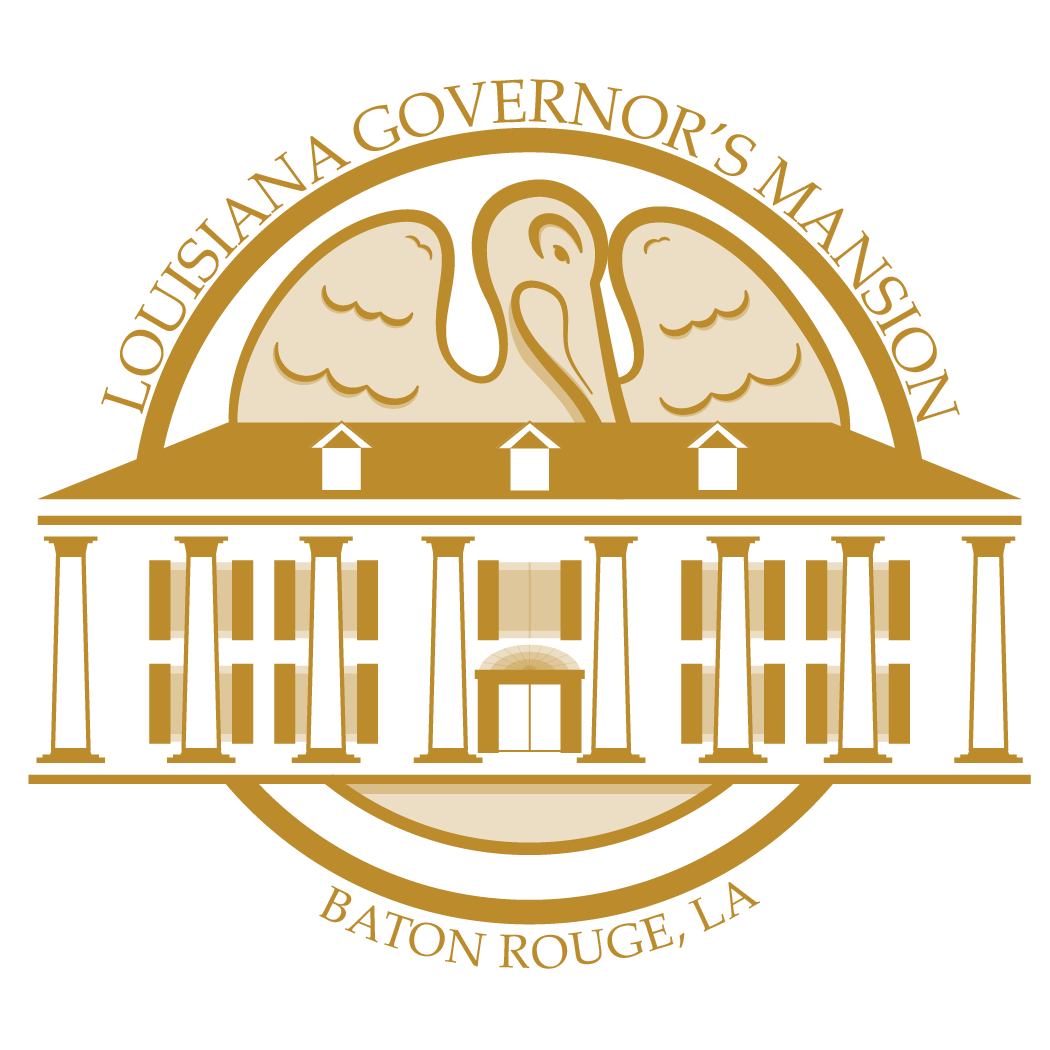History of Our Mansion
Mansion Background
The Governor’s Mansion was built in 1963 when Jimmie Davis served as governor of Louisiana. The mansion is located on Capitol Lake near the Louisiana State Capitol in Baton Rouge. Because so many antebellum mansions were being destroyed by fire and neglect, Governor and Mrs. Davis instructed the architects to design a mansion in the Greek Revival style, which was the dominant style in Louisiana after 1830. This period marks a distinct departure from earlier Louisiana architecture.
The mansion was designed by the architectural firm of Annan and Gilmer of Shreveport, Louisiana. The inspiration for the exterior design was Oak Alley Plantation in Vacherie, Louisiana. Like many antebellum homes built between 1830 and 1860, Oak Alley was designed with a second story veranda. However, the second-floor veranda was omitted because it was thought that it was too informal for a governor’s mansion. Although the new mansion is in the Greek Revival style, it also incorporates several Georgian features such as dormers, a fanlight of the doorway at the front entrance, and the long window along the circular stairs in the rotunda.
White Doric columns line the building on three sides. The columns are interrupted on the east side by a driveway leading to an underground garage. The exterior of the building is constructed of hand-molded brick that has been painted white. The roof is made of cleft-face Vermont non-fading, gray-green slate. Front and side porches are of the same type of slate. Lampposts located in the parking lot east of the mansion were once gas lights used in Plymouth, England. The cast iron railing atop the driveway retaining walls and the second story windows was designed from the railing used on the old Beauregard House on Chartres Street in New Orleans, but it was modified to include a diamond pattern by the architect.
The mansion sits on eight acres of land that includes a swimming pool, tennis court, fountain, and vegetable and flower gardens. The home itself contains a total of 25,000 square feet, three levels, a basement and an elevator. The mansion designers sought and achieved a level of convenience that blended the public and private living quarters almost seamlessly. Depending on the event, the downstairs areas can be opened or sequestered by closing strategically located doors.
Mansion Entrance
The front entrance fanlight and paneled double door, typical of the period after which the mansion was patterned, were inspired by the main doorway of the late Senator Robert Taft’s antebellum home in Ohio. The crystal globes on the light fixtures in the entrance vestibule, and the Adam lamp in the rotunda are etched with the state seal. Both were transferred from the old Governor’s Mansion.
The main entrance hall and rotunda are paved with marble that was quarried and fabricated in Italy. The two Empire Pier tables were purchased for the mansion during the administration of Governor David “Dave” Treen. They have an interesting history. The tables were acquired in about 1825 by Benjamin Gratz for his noted home in Lexington, Kentucky. The Meissen porcelain vases atop the tables, by designer Ernst August Lotharios, circa 1885, were given to the Louisiana Governor’s Mansion Foundation in October of 1997 by Dan Heard of Baton Rouge.
Rotunda
The spectacular marble motif in the rotunda contains a six-foot diameter slab with pieces of marble forming the state seal. This seal is inlaid with approximately 2,500 pieces of marble incised into the marble cartwheel. It is a masterpiece of detail and took the artist and two assistants more than six weeks to complete. The eye of the pelican has more than 25 individual pieces of colored marble. It should be noted that the base of the seal contains a magnolia blossom. The designer used his artistic license in incorporating the magnolia since it is not part of our official state seal.
The portraits of the governors who have lived in the mansion are hanging above the circular staircase. These portraits were commissioned by the Louisiana Governor’s Mansion Foundation and were reproduced from official photographs taken when each governor held the office.
State Dining Room
The State Dining Room is used as a meeting room by the governor for important, large conferences. The current table is modeled after the original table, which was an 18th century reproduction made with six-pedestals and a 21 foot antique table top from England, which was made to extend to 25 feet with added leaves. A few interesting facts to note: the wood is all from one flitch, and it can be used as one table or can be arranged as six separate tables.
The original dining room chairs were a set of twenty four upholstered armchairs that were modified copies of 18th century Hepplewhite chairs and as were used on sailing vessels carrying wealthy, titled Englishmen to the Near East. Women of Louisiana needlepointed the backs and seats of these chairs, incorporating magnolias into the design. Since then they have become known as the “magnolia chairs.” Thirteen of twenty-four chairs remain.
Two Empire Pier tables located on the east wall flank the fireplace. They were purchased during the Treen administration.
The Howe sideboard was donated during the renovation of the mansion when Governor Treen was in office. Adorning the Howe sideboard is a pair of early 19th century patented brass pedestal garniture vases. Each includes a cornucopia-shaped vase with a beaded acanthus-decorated rim continuing to an acanthus, waterleaf and anthemion support terminating in a ram’s head above a rectangular plinth with garlands centering a spread-wing butterfly on a stepped base with a frieze of floral decoration.
Originally, the fireplace in the State Dining room had a wooden mantle that was a replica of a similar mantle at the Ormond Plantation near New Orleans. However, during the Treen renovation, the wooden mantle was replaced with a marble mantle.
Governors and First Spouses
Who live or have lived in the current Governor’s Mansion:
- James “Jimmie” H. Davis and Alvern Adams (1960-1964)
- John J. McKeithen and Marjorie Funderburk (1964-1972)
- Edwin Edwards and Elaine S. Edwards (1972-1980, 1984-1988)
- Edwin Edwards and Candace Picou Linschoten (1992-1996)
- David C. Treen and Dolores Brisbi (1980-1984)
- Charles “Buddy” E. Roemer and Patti Roemer (1988-1992)
- Murphy “Mike” J. Foster and Alice Foster (1996-2004)
- Kathleen Babineaux Blanco and Raymond Blanco (2004-2008)
- Bobby Jindal and Supriya Jindal (2008-2016)
- John Bel Edwards and Donna Hutto Edwards (2016-2024)
- Jeff Landry and Sharon Landry (2024-2028)

